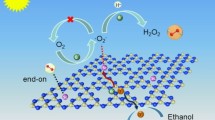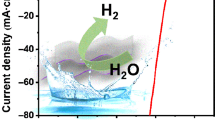Abstract
The hydrogen iodide decomposition reaction of the sulfur-iodine (SI) cycle is realized by electrolysis at room temperature to achieve efficient hydrogen production, while iodine is recycled throughout the SI reaction. In this work, we report a facile hydrothermal method for the synthesis of sulfur-doped titanium dioxide (S-\(\hbox {TiO}_2\)) nanosheets with evenly distributed on the Ti foil (S-\(\hbox {TiO}_2\)/Ti). The noble metal-free S-\(\hbox {TiO}_2\)/Ti electrode demonstrates excellent electrochemical catalytic performance for iodine evolution reaction. It can deliver a high current density of 100 mA/\(\hbox {cm}^2\) with a potential of 1.05 V, which is close to 90% of that of precious metal platinum and 5.6 times of bare Ti foil. Furthermore, the S-\(\hbox {TiO}_2\)/Ti electrode is stable in a mixed acid solution of HI and \(\hbox {H}_2\hbox {SO}_4\). Compared to \(\hbox {TiO}_2\)/Ti, diffuse reflectance spectroscopy and ultraviolet photoelectron spectroscopy analysis evidence a reduction in the band gap and work function of S-\(\hbox {TiO}_2\)/Ti due to the doping of sulfur. Correspondingly, the current efficiency approaches to 100% under the electrolysis constant voltage 1.30 V. Eventually, the detailed mechanism to describe the improvement of the electrocatalytic performance was suggested.
Graphical abstract








Similar content being viewed by others
Data availability
Measured data available upon request.
References
Monga D, Shetti NP, Basu S, Kakarla RR (2023) Recent advances in various processes for clean and sustainable hydrogen production. Nano-Struct & Nano-Objects 33:100948. https://doi.org/10.1016/j.nanoso.2023.100948
Kumar RS, Ramakrishnan S, Prabhakaran S, Kim AR, Kumar DR, Kim DH, Yoo DJ (2022) Structural, electronic, and electrocatalytic evaluation of spinel transition metal sulfide supported reduced graphene oxide. J Mater Chem A 10(4):1999–2011. https://doi.org/10.1039/D1TA08224H
Karthikeyan S, Santhosh Kumar R, Ramakrishnan S, Prabhakaran S, Kim AR, Kim DH, Yoo DJ (2022) Efficient alkaline water/seawater electrolysis by development of ultra-low \({\text{ IrO}_{2}}\) nanoparticles decorated on hierarchical \({\text{ MnO}_{2}}\)/RGO nanostructure. ACS Sustain Chem Eng 10(46):15068–15081. https://doi.org/10.1021/acssuschemeng.2c04074
Lee JE, Shafiq I, Hussain M, Lam SS, Rhee GH, Park Y-K (2022) A review on integrated thermochemical hydrogen production from water. Int J Hydrogen Energy 47(7):4346–4356. https://doi.org/10.1016/j.ijhydene.2021.11.065
O’keefe D, Allen C, Besenbruch G, Brown L, Norman J, Sharp R, McCorkle K (1982) Preliminary results from bench-scale testing of a sulfur-iodine thermochemical water-splitting cycle. Int J Hydrogen Energy 7(5):381–392. https://doi.org/10.1016/0360-3199(82)90048-9
Nomura M, Fujiwara S, Ikenoya K, Kasahara S, Nakajima H, Kubo S, Hwang G-J, Choi H-S, Onuki K (2004) Application of an electrochemical membrane reactor to the thermochemical water splitting is process for hydrogen production. J Membr Sci 240(1–2):221–226. https://doi.org/10.1016/j.memsci.2004.03.046
Liu H, Ye H, Zhou Z, Dong H (2023) A comprehensive evaluation integrating thermodynamics and mechanism kinetics for the Bunsen reaction in a sustainable iodine-sulfur cycle. Int J Hydrogen Energy. https://doi.org/10.1016/j.ijhydene.2023.06.131
Wang H (2007) Hydrogen production from a chemical cycle of \({\text{ H}_{2}\text{ S }}\) splitting. Int J Hydrogen Energy 32(16):3907–3914. https://doi.org/10.1016/j.ijhydene.2007.05.030
Wang H, Le Person A, Zhao X, Li J, Nuncio P, Yang L, Moniri A, Chuang KT (2013) A low-temperature hydrogen production process based on \({\text{H}_{2}\text{S}}\) splitting cycle for sustainable oil sands bitumen upgrading. Fuel Process Technol 108:55–62. https://doi.org/10.1016/j.fuproc.2012.04.010
Li J, Moniri A, Wang H (2015) Apparent kinetics of a gas–liquid–liquid system of Bunsen reaction with iodine-toluene solution for hydrogen production through \({\text{H}_{2}\text{S}}\) splitting cycle. Int J Hydrogen Energy 40(7):2912–2920. https://doi.org/10.1016/j.ijhydene.2014.12.073
Ying Z, Zheng X, Zhang Y, Cui G (2017) Development of a novel flowsheet for sulfur-iodine cycle based on the electrochemical Bunsen reaction for hydrogen production. Int J Hydrogen Energy 42(43):26586–26596. https://doi.org/10.1016/j.ijhydene.2017.09.035
Nomura M, Nakao S-I, Okuda H, Fujiwara S, Kasahara S, Ikenoya K, Kubo S, Onuki K (2004) Development of an electrochemical cell for efficient hydrogen production through the is process. AIChE J 50(8):1991–1998. https://doi.org/10.1002/aic.10162
Zhang K, Zhao X, Chen S, Chang L, Wang J, Bao W, Wang H (2018) Direct electrolysis of Bunsen reaction product \({\text{ HI }}/{\text{H}_{2}\text{SO}_{4}}/{\text{ H}_{2}\text{ O }}\)/toluene mixture for hydrogen production: Pt electrode characterization. Int J Hydrogen Energy 43(30):13702–13710. https://doi.org/10.1016/j.ijhydene.2018.02.079
Wu Z, Yang P, Li Q, Xiao W, Li Z, Xu G, Liu F, Jia B, Ma T, Feng S et al (2023) Microwave synthesis of Pt clusters on black \({\text{ TiO}_{2}}\) with abundant oxygen vacancies for efficient acidic electrocatalytic hydrogen evolution. Angew Chem 135(14):202300406. https://doi.org/10.1002/ange.202300406
Zhang J, Lei Y, Cao S, Hu W, Piao L, Chen X (2022) Photocatalytic hydrogen production from seawater under full solar spectrum without sacrificial reagents using \({\text{ TiO}_{2}}\) nanoparticles. Nano Res 15(3):2013–2022. https://doi.org/10.1007/s12274-021-3982-y
Alasri TM, Ali SL, Salama RS, Alshorifi FT (2023) Band-structure engineering of \({\text{ TiO}_{2}}\) photocatalyst by AuSe quantum dots for efficient degradation of malachite green and phenol. J Inorg Organomet Polymers Mater. https://doi.org/10.1007/s10904-023-02604-0
Zarach Z, Nowak AP, Trzciński K, Gajowiec G, Trykowski G, Sawczak M, Łapiński M, Szkoda M (2023) Influence of hydrochloric acid concentration and type of nitrogen source on the electrochemical performance of \({\text{ TiO}_{2}}/{\text{N-MoS}}_{2}\) for energy storage applications. Appl Surf Sci 608:155187. https://doi.org/10.1016/j.apsusc.2022.155187
González-Juárez E, Guzmán-Torres J, García-Gutiérrez D, García-Gutiérrez D, Pineda-Aguilar N, Garza-Tovar L, Sánchez-Cervantes E (2023) Effect of thermal treatment on the electrochemical performance of \({\text{ TiO}_{2}}\)(B)/anatase cathodes for \({\text{ Li}^{+}}/{\text{ Mg}^{2+}}\) batteries. J Mater Sci 58(9):4082–4093. https://doi.org/10.1007/s10853-023-08276-y
Hong S, Lee W, Hwang YJ, Song S, Choi S, Rhu H, Shim JH, Kim A (2023) Role of defect density in the \(\text{ TiO}_{\text{ x }}\) protective layer of the n-Si photoanode for efficient photoelectrochemical water splitting. J Mater Chem A 11(8):3987–3999. https://doi.org/10.1039/D2TA07082K
Umebayashi T, Yamaki T, Itoh H, Asai K (2002) Band gap narrowing of titanium dioxide by sulfur doping. Appl Phys Lett 81(3):454–456. https://doi.org/10.1063/1.1493647
Hwang G-J, Onuki K, Nomura M, Kasahara S, Kim J-W (2003) Improvement of the thermochemical water-splitting IS (iodine-sulfur) process by electro-electrodialysis. J Membr Sci 220(1–2):129–136. https://doi.org/10.1016/s0376-7388(03)00224-2
Yang T-S, Yang M-C, Shiu C-B, Chang W-K, Wong M-S (2006) Effect of \(\text{ N}_{2}\) ion flux on the photocatalysis of nitrogen-doped titanium oxide films by electron-beam evaporation. Appl Surf Sci 252(10):3729–3736. https://doi.org/10.1016/j.apsusc.2005.05.070
Chu D, Younis A, Li S (2012) Direct growth of \({\text{ TiO}_{2}}\) nanotubes on transparent substrates and their resistive switching characteristics. J Phys D Appl Phys 45(35):355306. https://doi.org/10.1088/0022-3727/45/35/355306
Bakar SA, Ribeiro C (2016) A comparative run for visible-light-driven photocatalytic activity of anionic and cationic S-doped \({\text{ TiO}_{2}}\) photocatalysts: a case study of possible sulfur doping through chemical protocol. J Mol Catal A Chem 421:1–15. https://doi.org/10.1016/j.molcata.2016.05.003
Elayappan V, Shanmugam R, Chinnusamy S, Yoo DJ, Mayakrishnan G, Kim K, Noh HS, Kim MK, Lee H (2020) Three-dimensional bimetal TMO supported carbon based electrocatalyst developed via dry synthesis for hydrogen and oxygen evolution. Appl Surf Sci 505:144642. https://doi.org/10.1016/j.apsusc.2019.144642
Ni J, Fu S, Wu C, Maier J, Yu Y, Li L (2016) Self-supported nanotube arrays of sulfur-doped \({\text{ TiO}_{2}}\) enabling ultrastable and robust sodium storage. Adv Mater 28(11):2259–2265. https://doi.org/10.1002/adma.201504412
Erdem B, Hunsicker RA, Simmons GW, Sudol ED, Dimonie VL, El-Aasser MS (2001) XPS and FTIR surface characterization of \({\text{ TiO}_{2}}\) particles used in polymer encapsulation. Langmuir 17(9):2664–2669. https://doi.org/10.1021/la0015213
Bhowmick S, Saini C, Santra B, Walczak L, Semisalova A, Gupta M, Kanjilal A (2023) Modulation of the work function of \({\text{ TiO}_{2}}\) nanotubes by nitrogen doping: Implications for the photocatalytic degradation of dyes. ACS Appl Nano Mater 6(1):50–60. https://doi.org/10.1021/acsanm.2c03587
Ohno T, Akiyoshi M, Umebayashi T, Asai K, Mitsui T, Matsumura M (2004) Preparation of S-doped \({\text{ TiO}_{2}}\) photocatalysts and their photocatalytic activities under visible light. Appl Catal A 265(1):115–121. https://doi.org/10.1016/j.apcata.2004.01.007
Poudel MB, Logeshwaran N, Kim AR, Karthikeyan S, Vijayapradeep S, Yoo DJ (2023) Integrated core-shell assembly of \({\text{ Ni}_{3}\text{S}_{2}}\) nanowires and CoMoP nanosheets as highly efficient bifunctional electrocatalysts for overall water splitting. J Alloys Compd. https://doi.org/10.1016/j.jallcom.2023.170678
Etghani SA, Ansari E, Mohajerzadeh S (2019) Evolution of large area \({\text{TiS}_{2}}-{\text{TiO}_{2}}\) heterostructures and S-doped \({\text{TiO}_{2}}\) nano-sheets on titanium foils. Sci Rep 9(1):17943. https://doi.org/10.1038/s41598-019-53651-y
Mukri BD, Waghmare UV, Hegde M (2013) Platinum ion-doped TiO2: high catalytic activity of \({\text{Pt}^{2+}}\) with oxide ion vacancy in \(\text{Ti}^{4+}_{1-\text{x}}\text{Pt}^{2+}_{\text{x}}\text{O}_{2-\text{x}}\) compared to \({\text{Pt}^{4+}}\) without oxide ion vacancy in \(\text{Ti}^{4+}_{1-\text{x}}\text{Pt}^{4+}_{\text{x}}\text{O}_{2}\). Chem Mater 25(19):3822–3833. https://doi.org/10.1021/cm4015404
Yang C, Wang Z, Lin T, Yin H, Lü X, Wan D, Xu T, Zheng C, Lin J, Huang F et al (2013) Core-shell nanostructured “black” rutile titania as excellent catalyst for hydrogen production enhanced by sulfur doping. J Am Chem Soc 135(47):17831–17838. https://doi.org/10.1021/ja4076748
Bacsa R, Kiwi J, Ohno T, Albers P, Nadtochenko V (2005) Preparation, testing and characterization of doped \({\text{ TiO}_{2}}\) active in the peroxidation of biomolecules under visible light. J Phys Chem B 109(12):5994–6003. https://doi.org/10.1021/jp044979c
Zhu M, Zhai C, Qiu L, Lu C, Paton AS, Du Y, Goh MC (2015) New method to synthesize S-doped \({\text{ TiO}_{2}}\) with stable and highly efficient photocatalytic performance under indoor sunlight irradiation. ACS Sustain Chem Eng 3(12):3123–3129. https://doi.org/10.1021/acssuschemeng.5b01137
Wang Y, Li J, Peng P, Lu T, Wang L (2008) Preparation of S-\({\text{ TiO}_{2}}\) photocatalyst and photodegradation of L-acid under visible light. Appl Surf Sci 254(16):5276–5280. https://doi.org/10.1016/j.apsusc.2008.02.050
Seo J, Park SY, Cho J, Lee J, Kim H-H, Lee K-M, Pham AL-T, Lee C (2021) Synergistic effects between the S-\({\text{ TiO}_{2}}\) photocatalyst and the fenton-like reagent: enhanced contaminant oxidation under visible light illumination. J Environ Chem Eng 9(1):104598. https://doi.org/10.1016/j.jece.2020.104598
Devi LG, Kavitha R (2014) Enhanced photocatalytic activity of sulfur doped \({\text{ TiO}_{2}}\) for the decomposition of phenol: a new insight into the bulk and surface modification. Mater Chem Phys 143(3):1300–1308. https://doi.org/10.1016/j.matchemphys.2013.11.038
Bredas J-L (2014) Mind the gap! Mater Horiz 1(1):17–19. https://doi.org/10.1039/c3mh00098b
Tang X, Li D (2008) Sulfur-doped highly ordered \({\text{ TiO}_{2}}\) nanotubular arrays with visible light response. J Phys Chem C 112(14):5405–5409. https://doi.org/10.1021/jp710468a
Cahen D, Kahn A (2003) Electron energetics at surfaces and interfaces: concepts and experiments. Adv Mater 15(4):271–277. https://doi.org/10.1002/adma.200390065
Mansfeldova V, Zlamalova M, Tarabkova H, Janda P, Vorokhta M, Piliai L, Kavan L (2021) Work function of \({\text{ TiO}_{2}}\) (anatase, rutile, and brookite) single crystals: effects of the environment. J Phys Chem C 125(3):1902–1912. https://doi.org/10.1021/acs.jpcc.0c10519
Maheu C, Cardenas L, Puzenat E, Afanasiev P, Geantet C (2018) UPS and UV spectroscopies combined to position the energy levels of \({\text{ TiO}_{2}}\) anatase and rutile nanopowders. Phys Chem Chem Phys 20(40):25629–25637. https://doi.org/10.1039/c8cp04614j
Kahn A (2016) Fermi level, work function and vacuum level. Mater Horiz 3(1):7–10. https://doi.org/10.1039/C5MH00160A
Naik B, Kim SM, Jung CH, Moon SY, Kim SH, Park JY (2014) Enhanced \({\text{ H}_{2}}\) generation of Au-loaded, nitrogen-doped \({\text{ TiO}_{2}}\) hierarchical nanostructures under visible light. Adv Mater Interfaces 1(1):1300018. https://doi.org/10.1002/admi.201300018
Xiao Z, Wang Y, Huang Y-C, Wei Z, Dong C-L, Ma J, Shen S, Li Y, Wang S (2017) Filling the oxygen vacancies in \(\text{ Co}_3\text{ O}_4\) with phosphorus: an ultra-efficient electrocatalyst for overall water splitting. Environ Sci Technol 10:2563–2569. https://doi.org/10.1039/c7ee01917c
Shu ZX, Bruckenstein S (1991) Iodine adsorption studies at platinum. J Electroanal Chem Interfacial Electrochem 317(1–2):263–277. https://doi.org/10.1016/0022-0728(91)85019-L
Wang L, Al-Mamun M, Liu P, Wang Y, Yang HG, Wang HF, Zhao H (2015) The search for efficient electrocatalysts as counter electrode materials for dye-sensitized solar cells: mechanistic study, material screening and experimental validation. NPG Asia Mater 7(11):226. https://doi.org/10.1038/am.2015.121
Acknowledgements
This work was supported by the Jilin province science and technology development projects (20170414025GH).
Author information
Authors and Affiliations
Contributions
XW involved in investigation, conceptualization, methodology, formal analysis, and writing original draft. TG involved in conceptualization, methodology, and formal analysis. R-JM and XWZ involved in methodology. HW involved in conceptualization, review and editing. XZ involved in conceptualization, resources, review and editing, and funding acquisition.
Corresponding author
Ethics declarations
Conflict of interest
All authors declare that they have no conflict of interest.
Ethical approval
Not applicable.
Additional information
Handling Editor: Pedro Camargo.
Publisher's Note
Springer Nature remains neutral with regard to jurisdictional claims in published maps and institutional affiliations.
Supplementary Information
Below is the link to the electronic supplementary material.
Rights and permissions
Springer Nature or its licensor (e.g. a society or other partner) holds exclusive rights to this article under a publishing agreement with the author(s) or other rightsholder(s); author self-archiving of the accepted manuscript version of this article is solely governed by the terms of such publishing agreement and applicable law.
About this article
Cite this article
Wang, X., Ma, RJ., Guo, T. et al. S-TiO2/Ti as efficient and stable electrocatalysts electrode for decomposition of HI to produce hydrogen. J Mater Sci 58, 15035–15046 (2023). https://doi.org/10.1007/s10853-023-08930-5
Received:
Accepted:
Published:
Issue Date:
DOI: https://doi.org/10.1007/s10853-023-08930-5




